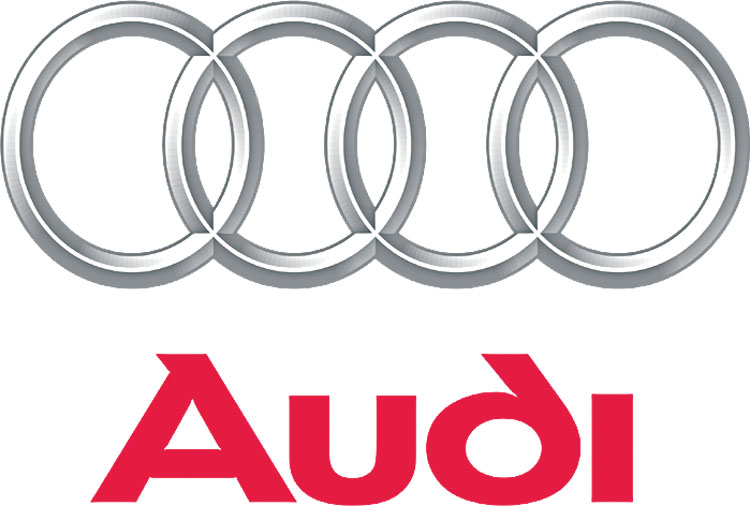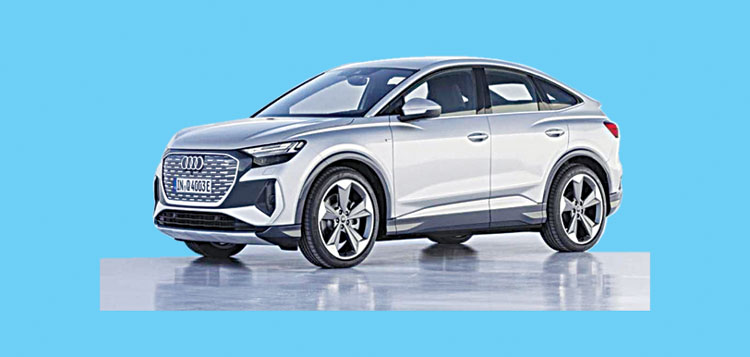
The production-spec Audi Q4 e-tron and Q4 Sportback e-tron have been revealed ahead of going on sale in international markets in the coming months. The Q4 is Audi’s fourth dedicated electric vehicle, following the e-tron, e-tron Sportback and the recently unveiled e-tron GT, and the first from the carmaker to be based on parent company Volkswagen Group’s MEB electric vehicle platform – as used for the Volkswagen ID 4 and Skoda Enyaq. The Q4 e-tron is produced in two distinct body styles – the standard SUV model places its emphasis on overall practicality, while a sleeker, rakish-roofed Sportback model aims for a more sporting market position.
The production versions retain largely the same design as their respective concepts, with a bluff front end dominated by a blanked-off grille, heavily structured air ducts, angular headlights with LED functionality, a contoured bonnet and deeply etched swage lines above each wheel arch. They are further differentiated by way of a subtly different treatment for the front bumper and grille. At the rear, the SUV model receives an angled rear screen within an upright tailgate, whereas the Sportback features a shallower liftback-style tailgate that’s similar in design to that of the larger E-tron Sportback. As is customary on each of Audi’s production electric vehicles, both have a wraparound brake light bar with distinctive LED graphics. The wheel sizes vary from 19 inches to 21 inches. At 4,590mm long, 1,865mm wide and 1,613mm tall, the Q4 e-tron SUV is 185mm shorter, 15mm wider and 13mm taller than its Tesla Model Y rival. A 2,760mm wheelbase endows it with relatively short overhangs and – in combination with its skateboard-style platform that features a flat floor – an interior that is described by Audi as being among “the longest in its class”. The German carmaker puts the drag coefficient of the SUV at 0.28 and the sleeker Sportback at 0.26.
Inside, the two Q4s adopt their own specially designed dashboard and cabin architecture. Key elements include a new steering wheel with touch-sensitive controls, a 10.25-inch digital instrument display with unique graphics and a standard 10.1-inch (optional 11.6-inch) central infotainment touchscreen combined with a ‘Hey Audi’ voice control function as an option. The Q4 e-tron is also the first Audi model to feature an augmented-reality head-up display, with information, including moving navigation commands, projected onto the windscreen in two separate fields and with varying depth of field. To accommodate the battery, the rear bench seat is mounted 70mm higher than the front seats in their lowest setting. Moving to boot space, the Q4 SUV packs in a 520-litre boot, which is expandable to 1,490 litres when the 40:20:40-split rear seat is stowed. The Sportback offers a slightly higher 535 litres of space in the boot, which can be expanded to 1,460 litres. There is no provision for a front storage compartment, with the space underneath the bonnet occupied by the power electronics system.
Coming to the powertrains, the entry point to the Q4 line-up will be the Q4 35 e-tron that is powered by a rear-mounted electric motor delivering 170hp and 310Nm in combination with a 52kWh (net) lithium-ion battery. Tipping the scales at 1,890kg (1,895kg for the Sportback), it boasts an official 0-100kph time of 9.0sec and a range of up to 341km on the WLTP test cycle in SUV guise. The Sportback has a marginally higher 349km range. Next up is the rear-wheel-drive Q4 40 e-tron, which receives the same rear-mounted electric motor setup as the Q4 35 e-tron but raises power to 204hp (torque is unchanged at 310Nm) and battery capacity to 77kWh (net). Audi claims a 0-100kph time of 8.5sec and, in the SUV, a range of up to 520km (WLTP). Heading the range is the all-wheel-drive Q4 50 e-tron quattro with front- and rear-mounted electric motors developing a combined 299hp and 460Nm, and packing a 77kWh battery. It offers a claimed 0-100kph time of 6.2sec and an estimated range of 488km and 497km for the SUV and Sportback, respectively.

